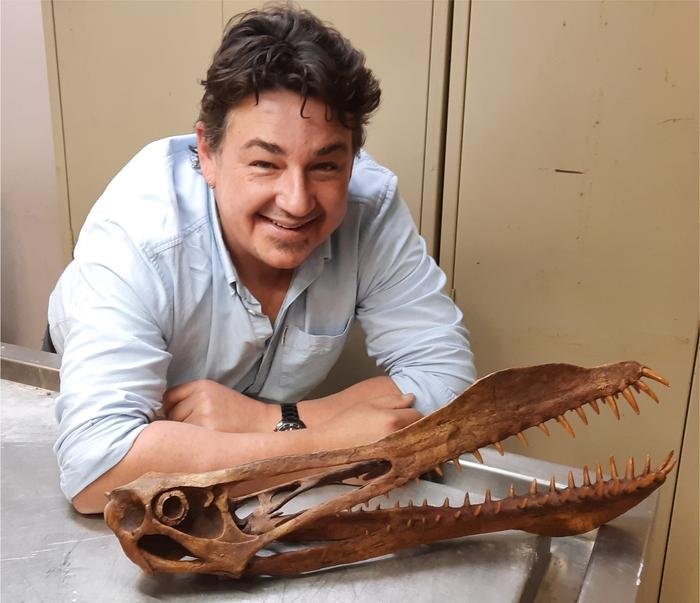Paleontologist Tim Richards is pictured with an anhanguerian pterosaur skull, a group that includes the newly discovered species Thapunngaka shawi -- which the scientist called "the closest thing we have to a real life dragon." Photo by Tim Richards
Aug. 9 (UPI) -- Paleontologists in Australia have uncovered the remains of a massive pterosaur from outback Queensland.
The continent's largest flying reptile, described Monday in the Journal of Vertebrate Paleontology, boasted a wingspan of nearly 23 feet.
The remains of the fearsome predator suggest its wings weren't its only intimidating feature. The reptile's massive mouth featured long, sharp teeth.
"It's the closest thing we have to a real life dragon," lead author Tim Richards said in a press release.
"It was essentially just a skull with a long neck, bolted on a pair of long wings. This thing would have been quite savage. It would have cast a great shadow over some quivering little dinosaur that wouldn't have heard it until it was too late," said Richards, a paleontologist and postdoctoral candidate at the University of Queensland.
The name of the new pterosaur species, Thapunngaka shawi, was inspired by the now-extinct language of the Wanamara Nation, the indigenous Australian people of western Queensland.
"The genus name, Thapunngaka, incorporates thapun [ta-boon] and ngaka [nga-ga], the Wanamara words for 'spear' and 'mouth,' respectively," co-author Steve Salisbury, Richard's doctoral supervisor, said in the release.
The species name is a nod to the name of the local fossil hunter, Len Shaw, who first discovered the pterosaur's bones in a Queensland quarry. The reptile's scientific name roughly translates to "Shaw's spear mouth."
Thapunngaka shawi is currently on display at Kronosaurus Korner, a marine fossil museum in Richmond, Australia.
The newly named species belonged to a group of pterosaurs known as anhanguerians, which dominated the skies above every continent during the Cretaceous, from around 140 to 92.5 million years ago.
Scientists estimate the newly discovered flying reptile used its massive skull, measuring more than three feet long, to scoop fish up from Queensland's Eromanga Sea, which dried up some 66 million years ago.
Australia's dragon-like pterosaur was able to keep its intimidating frame airborne thanks to thin-walled, semi-hollow bones. Unfortunately, the reptile's lightweight bones don't preserve well, which is why pterosaur fossils are so rare.
"It's quite amazing fossils of these animals exist at all," Richards said.
"By world standards, the Australian pterosaur record is poor, but the discovery of Thapunngaka contributes greatly to our understanding of Australian pterosaur diversity," he said.















